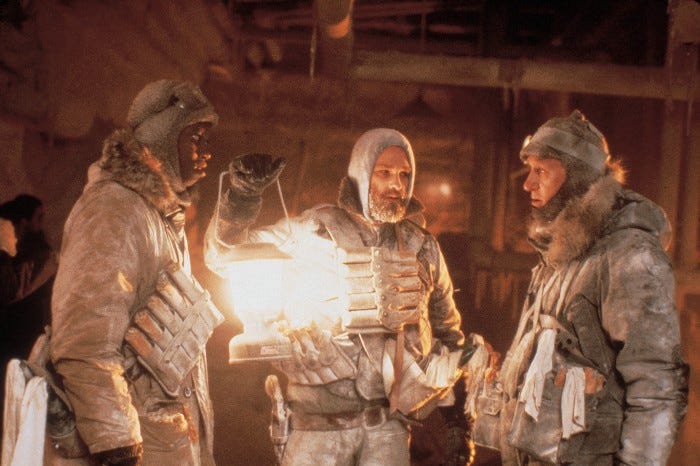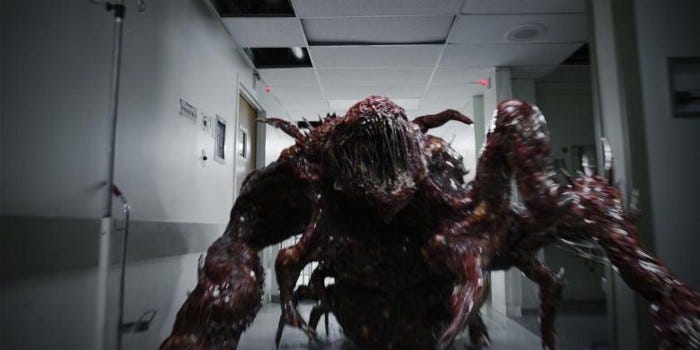The Thing: We Don’t Deserve a Genius Like John Carpenter
The world of film is indebted to Carpenter.
The last time I watched any portion of The Thing (1982) it was 2014 and I only saw the last thirty minutes. I could understand the creature’s ferocity and psychological warfare, but it was an incomplete picture, and a gaping hole in my cinephilia I didn’t correct until now. Carpenter’s 1982 classic is beloved by several of my counterparts within the film community, and as a John Carpenter fan myself, it was perennially on my to-watch list. Through a few quick internet searches, it’s apparent that this is a beloved film, confirmed by a societal, if not cultish appreciation for Carpenter and his ethos. The Thing, the titular character and the film itself, has an omnipresence and stealth method of assimilation. Perhaps that’s just Carpenter’s genius, or it’s the fact that a villain so stirring, so gloriously disturbing, paired with a compelling story, is once in a lifetime. The climactic moments scattered throughout the action in The Thing are disturbing and awe-inspiring, and the world of film is indebted to Carpenter.
I started the film from its beginning, prepared with a wide-eyed fascination, eager to bring my husband on the journey, anticipating the moves of the creature and excitement that piqued my interest long ago. I felt the same pangs of admiration with each sound queue, and body horror visual. It’s a feeling that only happens when you’re really wowed by something so landmark, so revolutionary. If any scene is deserving of wide-spread acclaim, it’s when the remaining survivors are tied up to test their infection rate, peak abyss in the psychological descent of Antarctic crew. The surviving men angered and shaking while R.J. MacGready tests blood samples to see if The Thing has co-opted another body is as potent a scene as Christopher Walken’s final moments in The Deer Hunter souped-up with immaculate special effects. We were hooked, with each phase of the plot more cunning and intriguing than the next, even if there were some motifs that felt familiar.
The familiarity astounded me upon this 2020 watch, and I could tell that the amount of theme, plot, and character was heavily borrowed. After my husband and I brainstormed, we realized how much culture had taken from The Thing beyond homage or allusion. That sort of admiration doesn’t usually bother me, but when I realized The Thing’s original 1982 reviews were less than stellar, I was angered. Why was it that The Thing was not critically acclaimed at its time of release, and why do we laud content like Stranger Things or the body of work from Guillermo Del Toro when it is not only an homage, but a true lift-and-shift into a globally-marketed film or television show? Carpenter had this same situation with his other films, and the next generation continued to create work with nods to his originals.
The critical history of The Thing and Carpenter’s 1970s-1980s work is mixed, with an underlying dismissal of his horror prowess as exploitative. With a retrospective eye, and after a blackout period in the 2000s, his position of influence has been reassessed in popular culture with appropriation of his work, and a devoted, outspoken following. The next generation understood his nuances, and the complexities of horror as a relatable subject. “It is always flattering to have somebody copy you,” he’s quoted in response to the iterations and allusions from countless other films such as Friday the 13th(1980) influenced by Carpenter’s Halloween (1978) or The Purge: Anarchy (2014) from They Live (1988).The irony is that his successors often received the immediate critical embrace he did not. If anything, it’s bizarre that The Thing is not in the pantheon of films that transcend their genre like Alien or Terminator. Yet alas, the critical eye in the 1980s was not onboard, and for whatever reason, John Carpenter could not transcend the genre. Much like Tarantino borrows heavily from 1970s exploitation films and wins Oscars, we’re living with the same circumstances within the horror genre.
Yet Carpenter himself doesn’t seem to mind this all too much. The humility of the director is apparent in his interviews, poking fun at his categorization:
“In England, I’m a horror movie director. In Germany, I’m a filmmaker. In the US, I’m a bum.”
As a fan, I think he deserves more than this. Hopefully one day the powers that be create an honorary Oscar or at least give him a shot at the Criterion Collection. He is not only a filmmaker, but an auteur and an inspiration. You’ll find an entire generation of horror filmmakers who have found his work as inspiring and Francis Ford Coppola’s or Vittorio De Sica’s. For audiences, we will always be there for every iteration of a Carpenter classic either for his organic creation itself or its assimilated contemporary pop cultural forms.






